display Seat Cordoba 2006 User Guide
[x] Cancel search | Manufacturer: SEAT, Model Year: 2006, Model line: Cordoba, Model: Seat Cordoba 2006Pages: 255, PDF Size: 7.57 MB
Page 64 of 255
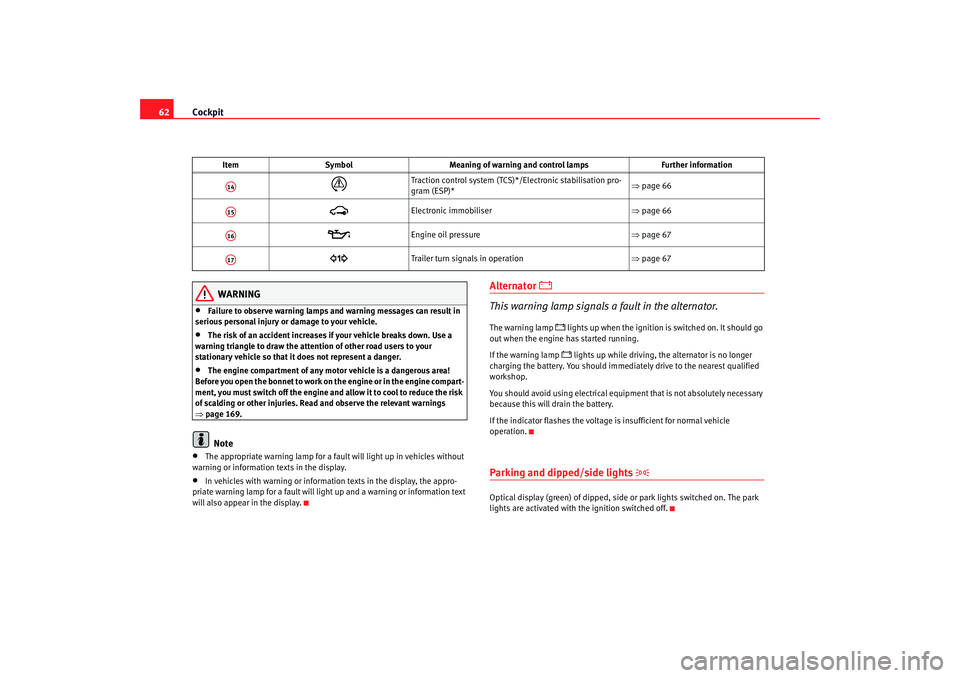
Cockpit
62
WARNING
•
Failure to observe warning lamps and warning messages can result in
serious personal injury or damage to your vehicle.
•
The risk of an accident increases if your vehicle breaks down. Use a
warning triangle to draw the attention of other road users to your
stationary vehicle so that it does not represent a danger.
•
The engine compartment of any motor vehicle is a dangerous area!
Before you open the bonnet to work on the engine or in the engine compart-
ment, you must switch off the engine and allow it to cool to reduce the risk
of scalding or other injuries. Read and observe the relevant warnings
⇒ page 169.Note
•
The appropriate warning lamp for a fa ult will light up in vehicles without
warning or information texts in the display.
•
In vehicles with warning or information texts in the display, the appro-
priate warning lamp for a fault will ligh t up and a warning or information text
will also appear in the display.
Alternator
This warning lamp signals a fault in the alternator.The warning lamp
lights up when the ignition is switched on. It should go
out when the engine has started running.
If the warning lamp lights up while driving, the alternator is no longer
charging the battery. You should immediately drive to the nearest qualified
workshop.
You should avoid using electrical equipment that is not absolutely necessary
because this will drain the battery.
If the indicator flashes the voltage is insufficient for normal vehicle
operation.
Parking and dipped/side lights
Optical display (green) of dipped, side or park lights switched on. The park
lights are activated with the ignition switched off.
Traction control system (TCS)*/Electronic stabilisation pro-
gram (ESP)* ⇒
page 66
Electronic immobiliser ⇒page 66
Engine oil pressure ⇒page 67
Trailer turn signals in operation
⇒ page 67
Item
Symbol Meaning of warning and control lamps Further information
A14A15A16A17
cordoba_ingles Seite 62 Freitag, 7. Oktober 2005 6:00 18
Page 120 of 255
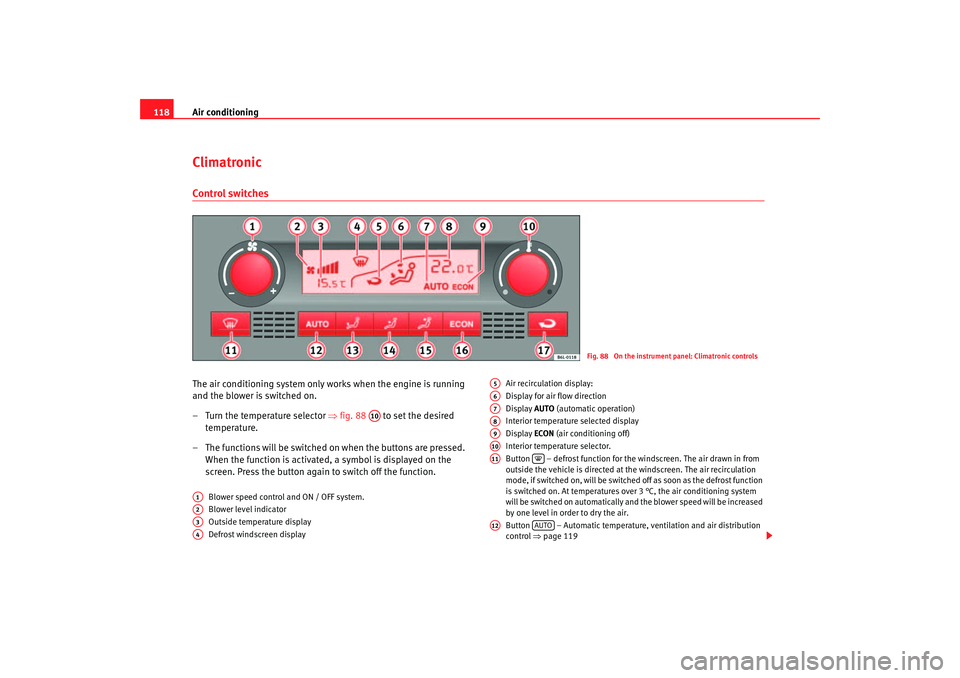
Air conditioning
118ClimatronicControl switchesThe air conditioning system only works when the engine is running
and the blower is switched on.
– Turn the temperature selector ⇒fig. 88 to set the desired
temperature.
– The functions will be switched on when the buttons are pressed. When the function is activated, a symbol is displayed on the
screen. Press the button again to switch off the function.
Blower speed control and ON / OFF system.
Blower level indicator
Outside temperature display
Defrost windscreen display Air recirculation display:
Display for air flow direction
Display
AUTO (automatic operation)
Interior temperature selected display
Display ECON (air condi tioning off)
Interior temperature selector.
Button – defrost function for the windscreen. The air drawn in from
outside the vehicle is directed at the windscreen. The air recirculation
mode, if switched on, will be switched off as soon as the defrost function
is switched on. At temperatures over 3 °C, the air conditioning system
will be switched on automatically and the blower speed will be increased
by one level in order to dry the air.
Button – Automatic temperature, ventilation and air distribution
control ⇒page 119
Fig. 88 On the instrument panel: Climatronic controls
A10
A1A2A3A4
A5A6A7A8A9A10A11
A12
AUTO
cordoba_ingles Seite 118 Freitag, 7. Oktober 2005 6:00 18
Page 121 of 255
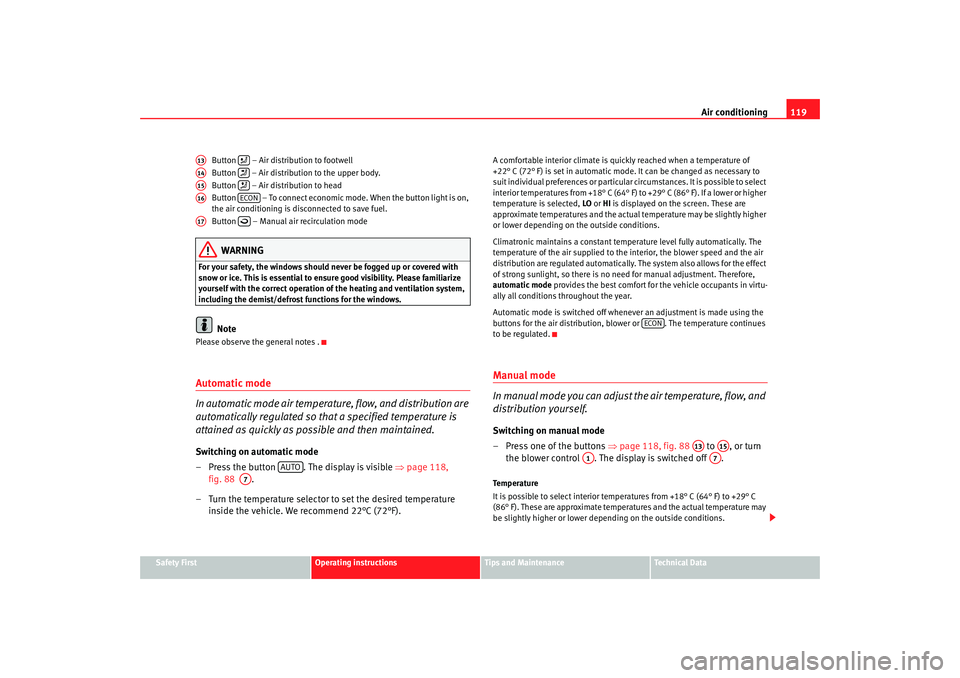
Air conditioning119
Safety First
Operating instructions
Tips and Maintenance
Te c h n i c a l D a t a
Button – Air distribution to footwell
Button – Air distribution to the upper body.
Button – Air distribution to head
Button – To connect economic mode. When the button light is on,
the air conditioning is disconnected to save fuel.
Button – Manual air recirculation mode
WARNING
For your safety, the windows should never be fogged up or covered with
snow or ice. This is essential to ensure good visibility. Please familiarize
yourself with the correct operation of the heating and ventilation system,
including the demist/defrost functions for the windows.
Note
Please observe the general notes .Automatic mode
In automatic mode air temperature, flow, and distribution are
automatically regulated so that a specified temperature is
attained as quickly as possible and then maintained.Switching on automatic mode
– Press the button . The display is visible ⇒
page 118,
fig. 88 .
– Turn the temperature selector to set the desired temperature inside the vehicle. We recommend 22°C (72°F).
A comfortable interior climate is quickly reached when a temperature of
+22° C (72° F) is set in automatic mode. It can be changed as necessary to
suit individual preferences or particular circumstances. It is possible to select
interior temperatures from +18° C (64° F) to +29° C (86° F). If a lower or higher
temperature is selected, LO or HI is displayed on the screen. These are
approximate temperatures and the actual temperature may be slightly higher
or lower depending on the outside conditions.
Climatronic maintains a constant temperature level fully automatically. The
temperature of the air supplied to the interior, the blower speed and the air
distribution are regulated automatically. The system also allows for the effect
of strong sunlight, so there is no n eed for manual adjustment. Therefore,
automatic mode provides the best comfort for the vehicle occupants in virtu-
ally all conditions throughout the year.
Automatic mode is switched off whenever an adjustment is made using the
buttons for the air distribution, blower or . The temperature continues
to be regulated.Manual mode
In manual mode you can adjust the air temperature, flow, and
distribution yourself.Switching on manual mode
– Press one of the buttons ⇒page 118, fig. 88 to , or turn
the blower control . The display is switched off .Temperature
It is possible to select interior temperatures from +18° C (64° F) to +29° C
(86° F). These are approximate temperat ures and the actual temperature may
be slightly higher or lower depending on the outside conditions.
A13
A14
A15
A16
ECON
A17
AUTO
A7
ECON
A13
A15
A1
A7
cordoba_ingles Seite 119 Freitag, 7. Oktober 2005 6:00 18
Page 122 of 255
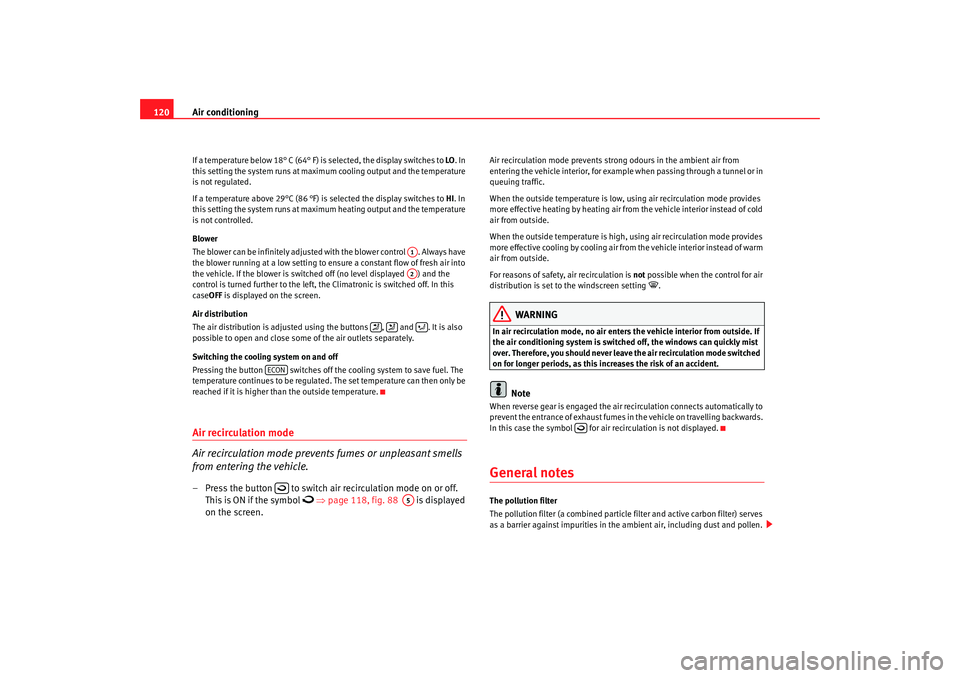
Air conditioning
120If a temperature below 18° C (64° F) is selected, the display switches to LO. In
this setting the system runs at maximum cooling output and the temperature
is not regulated.
If a temperature above 29°C (86 °F) is selected the display switches to HI. In
this setting the system runs at maximum heating output and the temperature
is not controlled.
Blower
The blower can be infinitely adjusted with the blower control . Always have
the blower running at a low setting to ensu re a constant flow of fresh air into
the vehicle. If the blower is switched off (no level displayed ) and the
control is turned further to the left, the Climatronic is switched off. In this
case OFF is displayed on the screen.
Air distribution
The air distribution is adjusted using the buttons , and . It is also
possible to open and close some of the air outlets separately.
Switching the cooling system on and off
Pressing the button switches off the cooling system to save fuel. The
temperature continues to be regulated. The set temperature can then only be
reached if it is higher than the outside temperature.Air recirculation mode
Air recirculation mode prevents fumes or unpleasant smells
from entering the vehicle.– Press the button to switch air recirculation mode on or off.
This is ON if the symbol
⇒ page 118, fig. 88 is displayed
on the screen.
Air recirculation mode pr events strong odours in the ambient air from
entering the vehicle interior, for example when passing through a tunnel or in
queuing traffic.
When the outside temperature is low, us ing air recirculation mode provides
more effective heating by heating air from the vehicle interior instead of cold
air from outside.
When the outside temperature is high, using air recirculation mode provides
more effective cooling by cooling air fr om the vehicle interior instead of warm
air from outside.
For reasons of safety, air recirculation is not possible when the control for air
distribution is set to the windscreen setting
.
WARNING
In air recirculation mode, no air enters the vehicle interior from outside. If
the air conditioning system is switched off, the windows can quickly mist
over. Therefore, you should never leave the air recirculation mode switched
on for longer periods, as this increases the risk of an accident.
Note
When reverse gear is engaged the air recirculation connects automatically to
prevent the entrance of exhaust fumes in the vehicle on travelling backwards.
In this case the symbol for air recirculation is not displayed.General notesThe pollution filter
The pollution filter (a combined particle filter and active carbon filter) serves
as a barrier against impurities in the ambient air, including dust and pollen.
A1A2
ECON
A5
cordoba_ingles Seite 120 Freitag, 7. Oktober 2005 6:00 18
Page 132 of 255
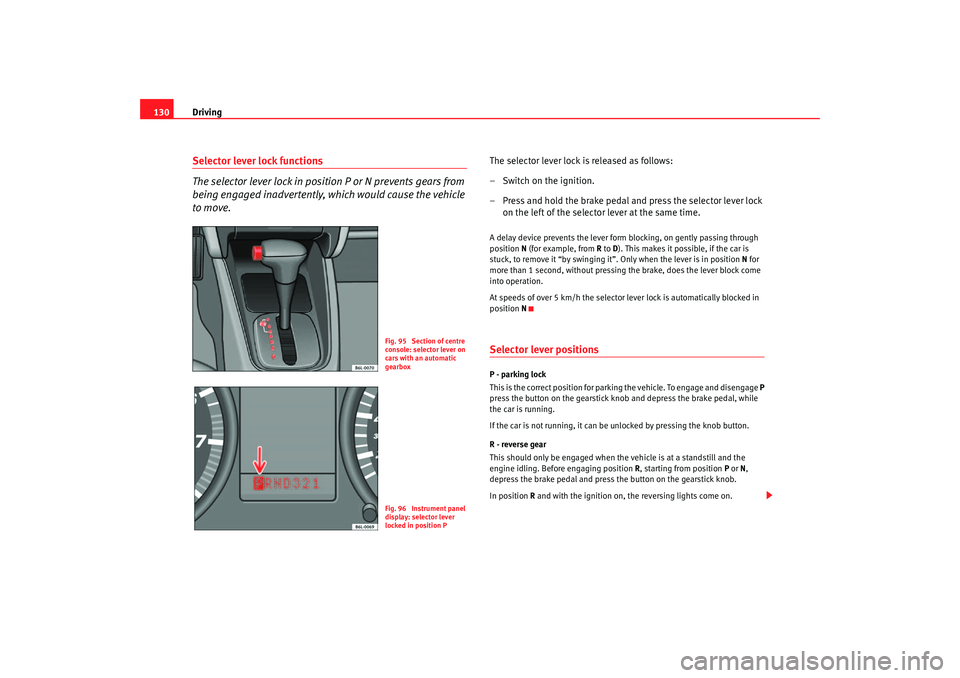
Driving
130Selector lever lock functions
The selector lever lock in positi on P or N prevents gears from
being engaged inadvertently, which would cause the vehicle
to move.
The selector lever lock is released as follows:
– Switch on the ignition.
– Press and hold the brake pedal and press the selector lever lock
on the left of the selector lever at the same time.A delay device prevents the lever form blocking, on gently passing through
positi on N (f or example,
from R to
D). This ma k
es it possible, if the ca r is
stuck, to remove it “by swinging it”. Only when the lever is in position N for
more than 1 second, without pressing th e brake, does the lever block come
into operation.
At speeds of over 5 km/h the selector lever lock is automatically blocked in
position N
Selector lever positionsP - parking lock
This is the correct pos ition
for parking the veh icle. To engage and di s
engage P
pre
ss th
e button on the gearstick knob and depress the brake pedal, while
the car is running.
If the car is not running, it can be unlocked by pressing the knob button.
R - reverse gear
This should only be engaged when the vehicle is at a standstill and the
engine idling. Before engaging position R, starting from position P or N,
depress the brake pedal and press the button on the gearstick knob.
In position R and with the ignition on, th e reversing lights come on.
Fig. 95 Section of centre
console: selector lever on
cars with an automatic
gearboxFig. 96 Instrument panel
display: selector lever
locked in position P
cordoba_ingles Seite 130 Freitag, 7. Oktober 2005 6:00 18
Page 174 of 255
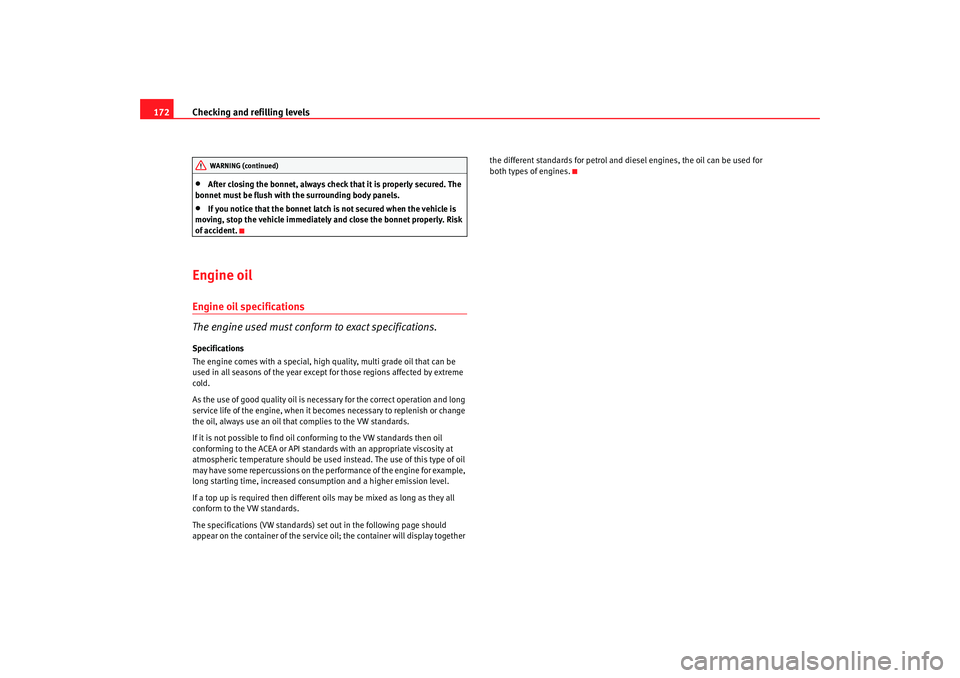
Checking and refilling levels
172•
After closing the bonnet, always check that it is properly secured. The
bonnet must be flush with the surrounding body panels.
•
If you notice that the bonnet latch is not secured when the vehicle is
moving, stop the vehicle immediately and close the bonnet properly. Risk
of accident.
Engine oilEngine oil specifications
The engine used must conform to exact specifications.Specifications
The engine comes with a special, high quality, multi grade oil that can be
used in all seasons of the year except for those regions affected by extreme
cold.
As the use of good qualit y oil is necessary for the correct operation and long
service life of the engine, when it be comes necessary to replenish or change
the oil, always use an oil that complies to the VW standards.
If it is not possible to find oil conforming to the VW standards then oil
conforming to the ACEA or API standards with an appropriate viscosity at
atmospheric temperature should be used instead. The use of this type of oil
may have some repercussions on the performance of the engine for example,
long starting time, increased consumption and a higher emission level.
If a top up is required then different oils may be mixed as long as they all
conform to the VW standards.
The specifications (VW standards) set out in the following page should
appear on the container of the service oil; the container will display together the different standards for petrol and diesel engines, the oil can be used for
both types of engines.
WARNING (continued)
cordoba_ingles Seite 172 Freitag, 7. Oktober 2005 6:00 18
Page 184 of 255
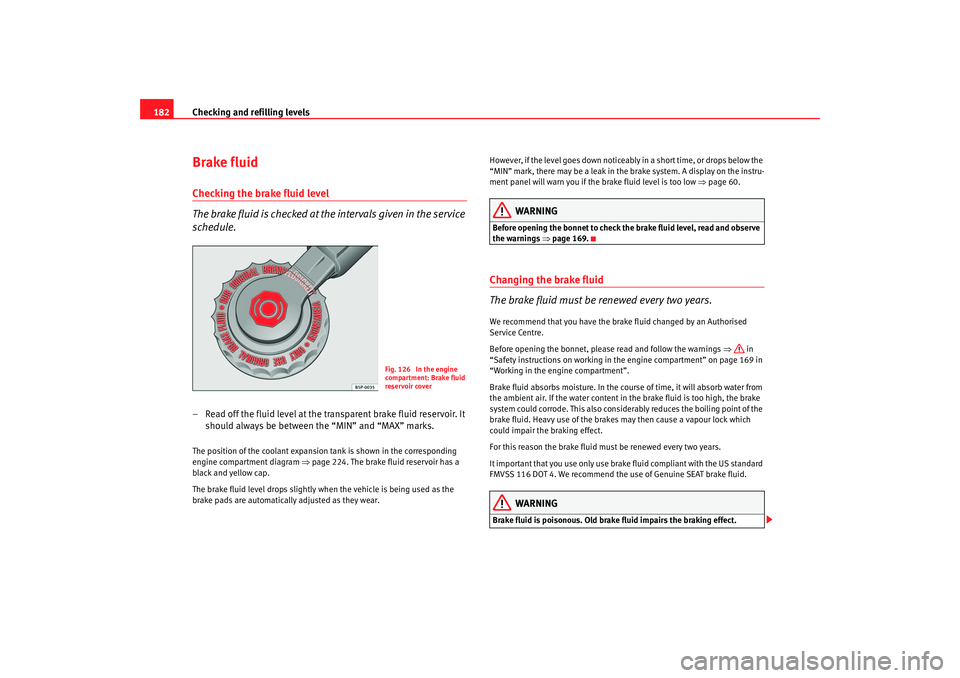
Checking and refilling levels
182Brake fluidChecking the brake fluid level
The brake fluid is checked at the intervals given in the service
schedule.– Read off the fluid level at the transparent brake fluid reservoir. It
should always be between the “MIN” and “MAX” marks.The position of the coolant expansion tank is shown in the corresponding
engine compartment diagram ⇒page 224. The brake fluid reservoir has a
black and yellow cap.
The brake fluid level drops slightly when the vehicle is being used as the
brake pads are automatically adjusted as they wear. However, if the level goes down noticeab
ly in a short time, or drops below the
“MIN” mark, there may be a leak in the brake system. A display on the instru-
ment panel will warn you if the brake fluid level is too low ⇒page 60.
WARNING
Before opening the bonnet to check the brake fluid level, read and observe
the warnings ⇒page 169.Changing the brake fluid
The brake fluid must be renewed every two years.We recommend that you have the brake fluid changed by an Authorised
Service Centre.
Before opening the bonnet, please read and follow the warnings ⇒ in
“Safety instructions on working in the engine compartment” on page 169 in
“Working in the engine compartment”.
Brake fluid absorbs moisture. In the cour se of time, it will absorb water from
the ambient air. If the water content in the brake fluid is too high, the brake
system could corrode. This also consider ably reduces the boiling point of the
brake fluid. Heavy use of the brakes may then cause a vapour lock which
could impair the braking effect.
For this reason the brake fluid must be renewed every two years.
It important that you use only use brake fluid compliant with the US standard
FMVSS 116 DOT 4. We recommend the use of Genuine SEAT brake fluid.
WARNING
Brake fluid is poisonous. Old brake fluid impairs the braking effect.
Fig. 126 In the engine
compartment: Brake fluid
reservoir cover
cordoba_ingles Seite 182 Freitag, 7. Oktober 2005 6:00 18
Page 186 of 255
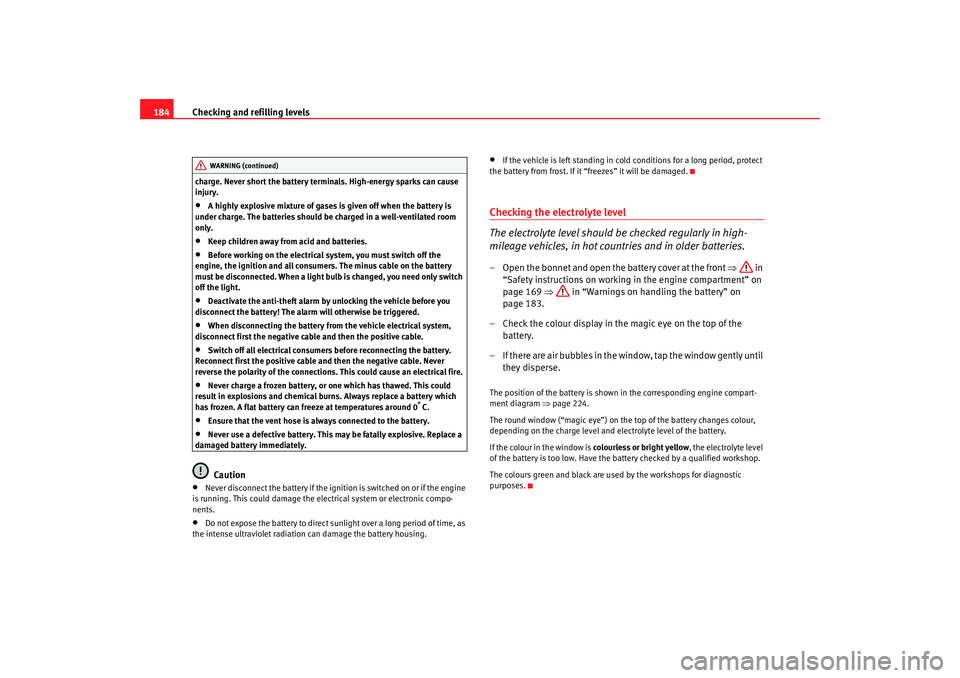
Checking and refilling levels
184charge. Never short the battery terminals. High-energy sparks can cause
injury.•
A highly explosive mixture of gases is given off when the battery is
under charge. The batteries should be charged in a well-ventilated room
only.
•
Keep children away from acid and batteries.
•
Before working on the electrical system, you must switch off the
engine, the ignition and all consumers. The minus cable on the battery
must be disconnected. When a light bulb is changed, you need only switch
off the light.
•
Deactivate the anti-theft alarm by unlocking the vehicle before you
disconnect the battery! The alarm will otherwise be triggered.
•
When disconnecting the battery from the vehicle electrical system,
disconnect first the negative cable and then the positive cable.
•
Switch off all electrical consumers before reconnecting the battery.
Reconnect first the positive cable and then the negative cable. Never
reverse the polarity of the connections. This could cause an electrical fire.
•
Never charge a frozen battery, or one which has thawed. This could
result in explosions and chemical burns. Always replace a battery which
has frozen. A flat battery can freeze at temperatures around 0
°C.
•
Ensure that the vent hose is always connected to the battery.
•
Never use a defective battery. This may be fatally explosive. Replace a
damaged battery immediately.Caution
•
Never disconnect the battery if the ignition is switched on or if the engine
is running. This could damage the electrical system or electronic compo-
nents.
•
Do not expose the battery to direct sunlight over a long period of time, as
the intense ultraviolet radiation can damage the battery housing.
•
If the vehicle is left standing in cold conditions for a long period, protect
the battery from frost. If it “freezes” it will be damaged.
Checking the electrolyte level
The electrolyte level should be checked regularly in high-
mileage vehicles, in hot countries and in older batteries.– Open the bonnet and open the battery cover at the front ⇒ in
“Safety instructions on working in the engine compartment” on
page 169 ⇒ in “Warnings on handling the battery” on
page 183.
– Check the colour display in the magic eye on the top of the battery.
– If there are air bubbles in the window, tap the window gently until they disperse.The position of the battery is show n in the corresponding engine compart-
ment diagram ⇒page 224.
The round window (“magic eye”) on the top of the battery changes colour,
depending on the charge level and electrolyte level of the battery.
If the colour in the window is colourless or bright yellow, the electrolyte level
of the battery is too low. Have the battery checked by a qualified workshop.
The colours green and black are used by the workshops for diagnostic
purposes.
WARNING (continued)
cordoba_ingles Seite 184 Freitag, 7. Oktober 2005 6:00 18
Page 247 of 255
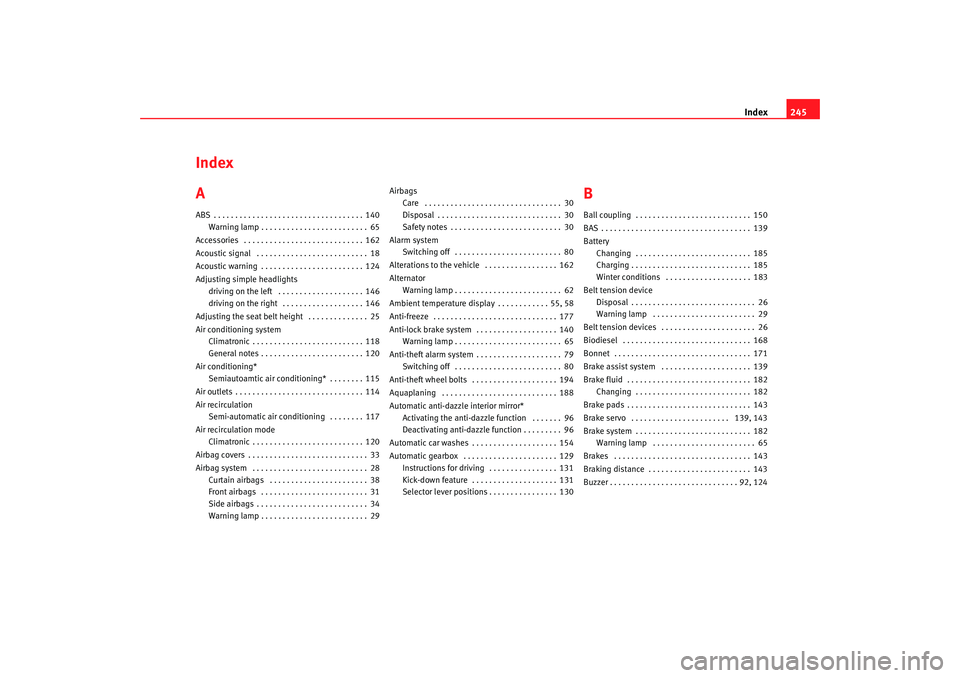
Index245
Index
AABS . . . . . . . . . . . . . . . . . . . . . . . . . . . . . . . . . . . 140
Warning lamp . . . . . . . . . . . . . . . . . . . . . . . . . 65
Accessories . . . . . . . . . . . . . . . . . . . . . . . . . . . . 162
Acoustic signal . . . . . . . . . . . . . . . . . . . . . . . . . . 18
Acoustic warning . . . . . . . . . . . . . . . . . . . . . . . . 124
Adjusting simp le headlights
driving on the left . . . . . . . . . . . . . . . . . . . . 146
driving on the right . . . . . . . . . . . . . . . . . . . 146
Adjusting the seat belt height . . . . . . . . . . . . . . 25
Air conditioning system Climatronic . . . . . . . . . . . . . . . . . . . . . . . . . . 118
General notes . . . . . . . . . . . . . . . . . . . . . . . . 120
Air conditioning* Semiautoamtic air conditioning* . . . . . . . . 115
Air outlets . . . . . . . . . . . . . . . . . . . . . . . . . . . . . . 114
Air recirculation Semi-automatic air conditi oning . . . . . . . . 117
Air recirculation mode Climatronic . . . . . . . . . . . . . . . . . . . . . . . . . . 120
Airbag covers . . . . . . . . . . . . . . . . . . . . . . . . . . . . 33
Airbag system . . . . . . . . . . . . . . . . . . . . . . . . . . . 28 Curtain airbags . . . . . . . . . . . . . . . . . . . . . . . 38
Front airbags . . . . . . . . . . . . . . . . . . . . . . . . . 31
Side airbags . . . . . . . . . . . . . . . . . . . . . . . . . . 34
Warning lamp . . . . . . . . . . . . . . . . . . . . . . . . . 29 Airbags
Care . . . . . . . . . . . . . . . . . . . . . . . . . . . . . . . . 30
Disposal . . . . . . . . . . . . . . . . . . . . . . . . . . . . . 30
Safety notes . . . . . . . . . . . . . . . . . . . . . . . . . . 30
Alarm system Switching off . . . . . . . . . . . . . . . . . . . . . . . . . 80
Alterations to the vehicle . . . . . . . . . . . . . . . . . 162
Alternator Warning lamp . . . . . . . . . . . . . . . . . . . . . . . . . 62
Ambient temperature display . . . . . . . . . . . . 55, 58
Anti-freeze . . . . . . . . . . . . . . . . . . . . . . . . . . . . . 177
Anti-lock brake system . . . . . . . . . . . . . . . . . . . 140 Warning lamp . . . . . . . . . . . . . . . . . . . . . . . . . 65
Anti-theft alarm system . . . . . . . . . . . . . . . . . . . . 79 Switching off . . . . . . . . . . . . . . . . . . . . . . . . . 80
Anti-theft wheel bolts . . . . . . . . . . . . . . . . . . . . 194
Aquaplaning . . . . . . . . . . . . . . . . . . . . . . . . . . . 188
Automatic anti-dazzle interior mirror* Activating the anti-dazzle function . . . . . . . 96
Deactivating anti-dazzle function . . . . . . . . . 96
Automatic car washes . . . . . . . . . . . . . . . . . . . . 154
Automatic gearbox . . . . . . . . . . . . . . . . . . . . . . 129 Instructions for driving . . . . . . . . . . . . . . . . 131
Kick-down feature . . . . . . . . . . . . . . . . . . . . 131
Selector lever positions . . . . . . . . . . . . . . . . 130
BBall coupling . . . . . . . . . . . . . . . . . . . . . . . . . . . 150
BAS . . . . . . . . . . . . . . . . . . . . . . . . . . . . . . . . . . . 139
BatteryChanging . . . . . . . . . . . . . . . . . . . . . . . . . . . 185
Charging . . . . . . . . . . . . . . . . . . . . . . . . . . . . 185
Winter conditions . . . . . . . . . . . . . . . . . . . . 183
Belt tension device Disposal . . . . . . . . . . . . . . . . . . . . . . . . . . . . . 26
Warning lamp . . . . . . . . . . . . . . . . . . . . . . . . 29
Belt tension devices . . . . . . . . . . . . . . . . . . . . . . 26
Biodiesel . . . . . . . . . . . . . . . . . . . . . . . . . . . . . . 168
Bonnet . . . . . . . . . . . . . . . . . . . . . . . . . . . . . . . . 171
Brake assist system . . . . . . . . . . . . . . . . . . . . . 139
Brake fluid . . . . . . . . . . . . . . . . . . . . . . . . . . . . . 182 Changing . . . . . . . . . . . . . . . . . . . . . . . . . . . 182
Brake pads . . . . . . . . . . . . . . . . . . . . . . . . . . . . . 143
Brake servo . . . . . . . . . . . . . . . . . . . . . . . 139, 143
Brake system . . . . . . . . . . . . . . . . . . . . . . . . . . . 182 Warning lamp . . . . . . . . . . . . . . . . . . . . . . . . 65
Brakes . . . . . . . . . . . . . . . . . . . . . . . . . . . . . . . . 143
Braking distance . . . . . . . . . . . . . . . . . . . . . . . . 143
Buzzer . . . . . . . . . . . . . . . . . . . . . . . . . . . . . . 92, 124
cordoba_ingles Seite 245 Freitag, 7. Oktober 2005 6:00 18
Page 249 of 255
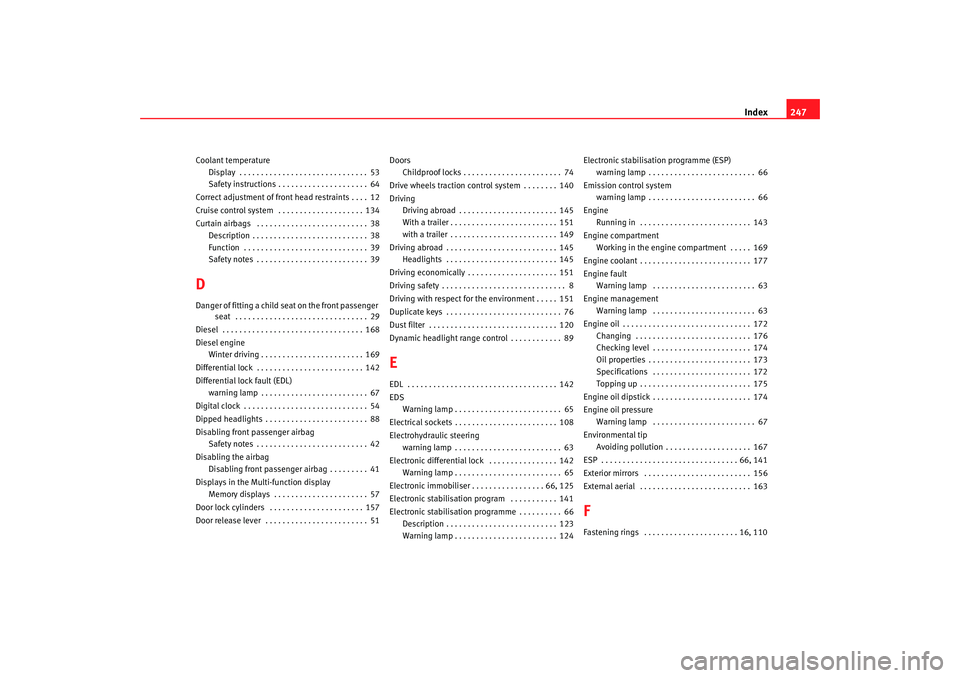
Index247
Coolant temperature
Display . . . . . . . . . . . . . . . . . . . . . . . . . . . . . . 53
Safety instructions . . . . . . . . . . . . . . . . . . . . . 64
Correct adjustment of front head restraints . . . . 12
Cruise control system . . . . . . . . . . . . . . . . . . . . 134
Curtain airbags . . . . . . . . . . . . . . . . . . . . . . . . . . 38 Description . . . . . . . . . . . . . . . . . . . . . . . . . . . 38
Function . . . . . . . . . . . . . . . . . . . . . . . . . . . . . 39
Safety notes . . . . . . . . . . . . . . . . . . . . . . . . . . 39DDanger of fitting a child seat on the front passenger seat . . . . . . . . . . . . . . . . . . . . . . . . . . . . . . . 29
Diesel . . . . . . . . . . . . . . . . . . . . . . . . . . . . . . . . . 168
Diesel engine Winter driving . . . . . . . . . . . . . . . . . . . . . . . . 169
Differential lock . . . . . . . . . . . . . . . . . . . . . . . . . 142
Differential lock fault (EDL) warning lamp . . . . . . . . . . . . . . . . . . . . . . . . . 67
Digital clock . . . . . . . . . . . . . . . . . . . . . . . . . . . . . 54
Dipped headlights . . . . . . . . . . . . . . . . . . . . . . . . 88
Disabling front passenger airbag Safety notes . . . . . . . . . . . . . . . . . . . . . . . . . . 42
Disabling the airbag Disabling front passenger airbag . . . . . . . . . 41
Displays in the Multi-function display Memory displays . . . . . . . . . . . . . . . . . . . . . . 57
Door lock cylinders . . . . . . . . . . . . . . . . . . . . . . 157
Door release lever . . . . . . . . . . . . . . . . . . . . . . . . 51 Doors
Childproof locks . . . . . . . . . . . . . . . . . . . . . . . 74
Drive wheels traction control system . . . . . . . . 140
Driving Driving abroad . . . . . . . . . . . . . . . . . . . . . . . 145
With a trailer . . . . . . . . . . . . . . . . . . . . . . . . . 151
with a trailer . . . . . . . . . . . . . . . . . . . . . . . . . 149
Driving abroad . . . . . . . . . . . . . . . . . . . . . . . . . . 145 Headlights . . . . . . . . . . . . . . . . . . . . . . . . . . 145
Driving economically . . . . . . . . . . . . . . . . . . . . . 151
Driving safety . . . . . . . . . . . . . . . . . . . . . . . . . . . . . 8
Driving with respect for the environment . . . . . 151
Duplicate keys . . . . . . . . . . . . . . . . . . . . . . . . . . . 76
Dust filter . . . . . . . . . . . . . . . . . . . . . . . . . . . . . . 120
Dynamic headlight range control . . . . . . . . . . . . 89
EEDL . . . . . . . . . . . . . . . . . . . . . . . . . . . . . . . . . . . 142
EDS Warning lamp . . . . . . . . . . . . . . . . . . . . . . . . . 65
Electrical sockets . . . . . . . . . . . . . . . . . . . . . . . . 108
Electrohydraulic steering warning lamp . . . . . . . . . . . . . . . . . . . . . . . . . 63
Electronic differential lock . . . . . . . . . . . . . . . . 142 Warning lamp . . . . . . . . . . . . . . . . . . . . . . . . . 65
Electronic immobiliser . . . . . . . . . . . . . . . . . 66, 125
Electronic stabilisation program . . . . . . . . . . . 141
Electronic stabilisation programme . . . . . . . . . . 66 Description . . . . . . . . . . . . . . . . . . . . . . . . . . 123
Warning lamp . . . . . . . . . . . . . . . . . . . . . . . . 124 Electronic stabilisation programme (ESP)
warning lamp . . . . . . . . . . . . . . . . . . . . . . . . . 66
Emission control system warning lamp . . . . . . . . . . . . . . . . . . . . . . . . . 66
Engine Running in . . . . . . . . . . . . . . . . . . . . . . . . . . 143
Engine compartment Working in the engine compartment . . . . . 169
Engine coolant . . . . . . . . . . . . . . . . . . . . . . . . . . 177
Engine fault Warning lamp . . . . . . . . . . . . . . . . . . . . . . . . 63
Engine management Warning lamp . . . . . . . . . . . . . . . . . . . . . . . . 63
Engine oil . . . . . . . . . . . . . . . . . . . . . . . . . . . . . . 172 Changing . . . . . . . . . . . . . . . . . . . . . . . . . . . 176
Checking level . . . . . . . . . . . . . . . . . . . . . . . 174
Oil properties . . . . . . . . . . . . . . . . . . . . . . . . 173
Specifications . . . . . . . . . . . . . . . . . . . . . . . 172
Topping up . . . . . . . . . . . . . . . . . . . . . . . . . . 175
Engine oil dipstick . . . . . . . . . . . . . . . . . . . . . . . 174
Engine oil pressure Warning lamp . . . . . . . . . . . . . . . . . . . . . . . . 67
Environmental tip Avoiding pollution . . . . . . . . . . . . . . . . . . . . 167
ESP . . . . . . . . . . . . . . . . . . . . . . . . . . . . . . . . 66, 141
Exterior mirrors . . . . . . . . . . . . . . . . . . . . . . . . . 156
External aerial . . . . . . . . . . . . . . . . . . . . . . . . . . 163
FFastening rings . . . . . . . . . . . . . . . . . . . . . . 16, 110
cordoba_ingles Seite 247 Freitag, 7. Oktober 2005 6:00 18